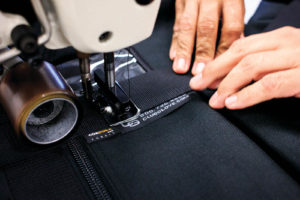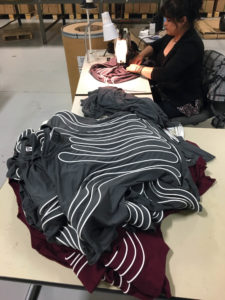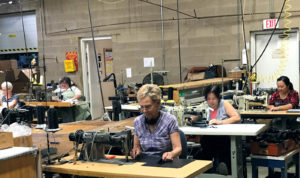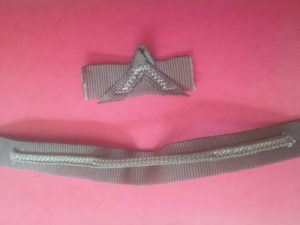
When U.S. textile jobs started to leave en masse for China and other cheap-labor countries in the 1990s, an entire industry scrambled to pick up the pieces. Companies that survived the upheaval frequently shared one common trait: adaptability. Some contract sewers courted niche non-apparel product makers, while others invested in equipment to become leaders in high-tech fabric finishing.
Although the consumer apparel market is unlikely to stage a full comeback in the United States, new opportunities in commercial and industrial sewing continue to emerge for sewing equipment manufacturers and contract sewers alike. To stay profitable in a constantly evolving and continually challenging industry, companies
in the sewn-goods market are employing several key strategies.
Go with the flow
The Fox Co., a distributor of sewing, cutting and spreading equipment in Charlotte, N.C., found itself in a precarious position after the exodus of apparel from the United States. “We dealt almost exclusively with American companies in the apparel industry, and lost a majority of our customer base either to closing down or moving offshore,” says Harry Berzack, president of The Fox Co. “We basically had to reinvent ourselves.”
That meant becoming involved in home furnishings, parachutes, industrial textiles, filtration—or, as Berzack puts it, “anything that can be sewn.”
In addition to apparel, mass-produced items like sheets and pillowcases, along with some awnings and window treatments, have gone offshore. Much of the work ends up in Mexico and Central America. The Fox Co. has a fully staffed stocking facility in Honduras, “but we still do a good proportion of our business onshore,” Berzack says.

One area experiencing growth in the United States is the medical industry, which is making products like gauze, splints and compression hosiery. In comparison to the height of the U.S. apparel industry, however, Berzack says “growth” is a relative term. For example, a T-shirt factory may buy 200 sewing machines; medical and other non-apparel specialties require many fewer machines because of smaller production runs.
“You also have to be a lot more specialized,” says Berzack. “Medical fabrics have different construction, and you need more knowledge about the machines because they have special add-ons.”
From custom to customer
A flexible approach to contract sewing has helped Jonco Industries Inc., Milwaukee, Wis., navigate the decline of sewing manufacturing in the U.S. The company is currently manufacturing custom tool pouches and toolbox covers, school uniforms, hats, specialty backpacks, car seat covers and changing blankets.
“We do a lot of work with businesses, but a large part of our growth comes from people at home who have ideas they want to go forward with,” says operations manager Jim Kittle.
Roeming Industries, Mequon, Wis., also has found a niche in turning entrepreneurs’ concepts into reality.
“I get calls from people all the time asking if we can help with a product they’d like to sell online, and we make prototypes for them,” says president Sandy Schumaker.
One such entrepreneur is Daniel Roeming, grandson of Roeming Industries’ founder. Roeming wanted to make life easier for his wife, who was doing in-home clothing shows and had to haul a heavy, sharp-edged rolling rack. Roeming collaborated with Schumaker (his aunt) and head seamstress Ruth Karrels to design a bag to carry the rack. Schumaker found a lightweight yet durable fabric, long zippers and webbing for the adjustable strap. After several alterations and trial runs, the bag made its debut on Amazon in 2017.
Cut-and-sew equipment manufacturers are also heeding customers’ calls for well-made custom products. Berzack recently met with someone who wanted to make high-end polo shirts that would sell for upwards of $200 apiece. In fact, Berzack forecasts an increase in specialized, boutique-type operations making high-quality specialized goods that require high-speed, high-tech machines.
Companies that offer their customers choices and respond to an increased demand for customization will have a better chance of staying in business, says Joe Eller, vice president of JUKI America Inc., Miami, Fla.
“Customization could mean custom sizing, possibly by use of body-scanning technology, or simply custom color and fabric selection,” Eller says. “Successful companies will offer these options with quick delivery, as their customers will want it now. It will require new skills in supply chain management and understanding of the various technologies available today.”
An automated approach

Digitalization and automation of the sewing industry are influencing companies to increase speed and efficiency while reducing errors and production costs in a highly competitive market. “Automation is always important, particularly when quality and productivity can both be improved above the level of using standard machines,” Eller says.
Today’s automation most often revolves around programmable machines and job-specific clamping. “These machines allow the customer to achieve a quality level that is not possible with manual machines, and to eliminate human error in the process,” Eller says.
He also encourages factories to take advantage of any available technology “to quickly change from one product to another and to monitor the factory production in real time so management can make changes quickly if necessary.”
JUKI America’s newest models include digital adjustment for tension, stitch length, feeding characteristics and other options, depending upon a customer’s product requirements.
Doug Glenn, vice president of sales at Consew Consolidated Sewing Machine Corp. in Carlstadt, N.J., says that automation can be an ergonomic tool that assists rather than fully replaces the operator.
“In some applications in the automotive and other industries, operators stand at the machines, which are waist-level or above and have remote pedals,” Glenn says. “In other applications, operators are in the seated position and can place their sewn products on a conveyor belt above or beside when they are finished sewing.” These setups also offer a simple way to increase production through material handling and work flow.
To attain the most value from automation, however, many companies want to automate as much of the sewing process as possible. In one industry example, Consew provides a machine for parachute makers that automatically takes a piece of webbing off the reel and measures and hot cuts it to length, folds the webbing onto itself, and then sews down to 12 inches, stops and trims. This creates a sewn, metered webbing loop that is applied to the parachute canopy.
“To do this manually, you would need a strip cutter, and then you would bring all those pieces over to an operator who would line everything up and sew with a double-needle machine,” Glenn says. “Automation can make a more consistent finished product and greatly increase production without having operators.”
Embracing technology can provide a competitive advantage. At its new 70,000-square-foot facility in Garden Grove, Calif., CustomFab USA has heavily invested in computerized sewing machines, enterprise resource planning (ERP) manufacturing software and automated cutting equipment to fabricate a wide range of soft goods for the medical, tactical gear, aerospace, and sports and fashion industries.
“Over the years we’ve seen a major leap forward with regard to the equipment becoming more versatile; that is, being able to automate and handle larger quantities of more specific types of materials,” says Don Alhanati, founder of CustomFab USA. “The technological upgrades we’ve implemented help with speed, performance and consistency.”
Thanks to the increase in productivity afforded by automation, CustomFab USA has been able to “significantly scale up our output without needing to scale outward too much in terms of our geological footprint.”
Alhanati expects automation to play an even more important role moving forward, as it allows for greater output at a faster pace. “It’s the future of manufacturing, and we’ve positioned ourselves to be at the cutting edge of the movement,” he says.
Help wanted

By the early 2000s, the American textile industry appeared dead in the water. But thanks to a bit of re-shoring and new product development in the United States, the commercial/industrial sewing industry now has positions to fill. The only trouble is finding workers with the skills—or the desire to learn the skills—to operate and maintain sewing equipment.
“We are now on our third generation of sewing machine operators, cutting machine people, pattern makers and mechanics who have lost their jobs and found something else to do,” Glenn says. “That leaves us with a real shortage of skilled labor.”
A fundamental problem in acquiring sewing talent is lack of awareness. “People don’t know that production sewing is a viable career path,” says Schumaker.
She encountered this predicament firsthand when The Makers Coalition of Southeastern Wisconsin worked with Milwaukee Area Technical College to offer a class on industrial sewing. “We couldn’t find people to take the class,” says Schumaker, noting that the coalition is trying to find new ways to raise awareness about the profession. “We want to keep the momentum going.”
Instead, the course was offered to personnel of companies in the coalition who aren’t sewers but wanted to learn about the craft. Additionally, the state of Wisconsin awarded a $30,000 grant that was used to train other coalition member employees in the areas of supervision and leadership.
The Makers Coalition Foundation consists of businesses, educational institutions and nonprofit organizations working together to find and train the next generation of industrial sewing operators, to meet future industry demands. The Coalition and the Industrial Fabrics Association International (IFAI) have formed a partnership to strengthen the industry, train a new generation of sewers and create a workforce pipeline. Tarrant County College, for example, is a Makers curriculum partner and offers a multi-level upholstery program. (For information on the programs and resources being offered by IFAI and the Makers Division, visit http://makers.ifai.com.)
Equally important to attaining workers is retaining them. CustomFab USA has a skilled workforce of 275-plus machine operators and administrators, some of whom have worked for the 25-year-old company as long as it has been in business.
“When it comes to maintaining our workforce, our best strategy is to treat our employees as family,” Alhanati says. “That means being invested in their education, training and treating them with respect.”
Holly O’Dell is a business writer based in Joshua Tree, Calif.
 TEXTILES.ORG
TEXTILES.ORG



